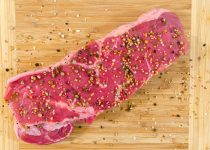What Is Rotisserie
You know that mouthwatering, juicy, and flavorful whole chicken or prime rib you love at the local rotisserie? That's rotisserie cooking at its finest. It's a method where meat is skewered and slowly roasted over a source of heat, resulting in tender, succulent, and evenly cooked dishes.
Whether you're using a rotisserie attachment for your grill or a standalone rotisserie oven, mastering this cooking technique can elevate your culinary skills and impress your guests. Rotisserie cooking allows for even browning and self-basting, making it a popular choice for creating delicious, restaurant-quality meals at home.
So, if you're ready to take your cooking game to the next level, mastering the art of rotisserie is a must.
Key Takeaways
- Rotisserie cooking originated in the 15th century in Europe and became a symbol of feasts and celebrations.
- Proper placement and balance of equipment are crucial for even cooking, including the rotisserie motor, spit rod, and heat source.
- The rotating motion of rotisserie cooking ensures even distribution of heat, retains natural flavors, and allows for thorough cooking.
- Techniques such as basting with juices or marinades help enhance flavor infusion, retain moisture, and preserve the natural flavors of the meat.
History of Rotisserie Cooking
In the 15th century, people across Europe began enjoying the benefits of rotisserie cooking, as it allowed for even roasting and browning of meats over an open flame. The evolution of rotisserie cooking can be traced back to this time, marking a significant development in culinary history.
Rotisserie cooking not only revolutionized the way meats were prepared but also held cultural significance in various societies. It became a symbol of feasts and celebrations, showcasing the mastery of culinary skills and the ability to provide succulent, evenly cooked meats for communal gatherings.
The cultural significance of rotisserie cooking is deeply rooted in the communal aspect of sharing a meal. It brought people together, fostering a sense of community and celebration. The evolution of rotisserie cooking also reflected advancements in culinary techniques and equipment, leading to the development of specialized rotisserie ovens and spits.
The historical journey of rotisserie cooking demonstrates how this method has transcended time, becoming a cherished tradition that continues to be celebrated in modern culinary practices.
Rotisserie Equipment and Setup
Let's talk about the basics of a rotisserie grill and how to set it up.
You'll need to understand the essential equipment and how to properly assemble it for successful rotisserie cooking.
Rotisserie Grill Basics
When setting up your rotisserie grill, ensuring the proper placement and balance of the equipment is crucial for achieving even cooking of your meats. To master the art of rotisserie grilling, it's important to understand the basics of rotisserie equipment and setup. Here are essential elements to take into consideration:
| Equipment | Placement | Balance |
|---|---|---|
| Rotisserie Motor | Position at the center back of the grill | Ensure it is securely attached and balanced with the weight of the meat |
| Spit Rod | Adjust to the proper height above the heat source | Balance the weight of the meat on the rod to prevent uneven cooking |
| Heat Source | Place coals or set the gas burners | Evenly distribute the heat under the meat for consistent cooking |
Mastering these basics, along with experimenting with rotisserie grill techniques and various rotisserie seasoning options, will elevate your grilling game.
Setting up Rotisserie Equipment
You should begin by positioning the rotisserie motor at the center back of the grill and ensuring it's securely attached and balanced with the weight of the meat. Follow these steps for setting up your rotisserie equipment:
- Secure Attachment: Ensure the spit rod is properly inserted and secured in place, preventing any wobbling during rotation.
- Proper Alignment: Position the meat evenly on the spit rod, ensuring it's centered to maintain balance and prevent motor strain.
- Check Clearance: Verify that there's enough clearance between the meat and the grill hood to avoid any potential contact and ensure even cooking.
- Maintenance and Cleaning: Regularly inspect and clean the rotisserie components, including the motor, spit rod, and forks, to prevent grease buildup and ensure smooth operation.
Following these steps will help you set up your rotisserie equipment for optimal performance, maintenance, and cleaning.
Rotisserie Cooking Process
When you cook food on a rotisserie, the rotating motion ensures that the heat is distributed evenly, resulting in thorough cooking.
This process also helps retain the natural flavors of the food, producing delicious, succulent results.
The end product is often juicy and tender, making rotisserie cooking a popular choice for many.
Rotating Food for Even Cooking
To achieve even cooking, rotate the food continuously on the rotisserie skewer, allowing the heat to circulate and cook the entire surface evenly. This process ensures that the meat or vegetables are cooked to perfection, with a deliciously crisp exterior and a juicy, flavorful interior.
Here's how to master the rotisserie cooking process:
- Balance: Ensure that the food is evenly balanced on the skewer to prevent uneven cooking and potential accidents.
- Temperature Control: Adjust the heat settings to maintain an even temperature throughout the cooking process, preventing hot spots and ensuring uniform cooking.
- Basting: Regularly baste the food with juices or marinades to enhance flavor infusion and keep the surface moist during cooking.
- Monitoring: Keep a close eye on the cooking progress to make any necessary adjustments and ensure a consistent, even cook.
Retaining Natural Flavors
Retaining natural flavors during the rotisserie cooking process is achieved by consistently basting the food with juices or marinades to enhance flavor infusion and maintain surface moisture. This method ensures that the meat remains juicy and succulent while cooking, preserving its natural flavors.
By continuously basting the food as it rotates, you effectively retain moisture, preventing the meat from drying out and losing its inherent taste. The rotation allows for uniform distribution of the natural juices, resulting in a flavorful and tender outcome.
Additionally, the constant rotation helps to prevent the loss of natural juices, keeping the meat moist and flavorful. By implementing these techniques, you can elevate the taste of your rotisserie-cooked dishes, ensuring that they aren't only cooked evenly but also bursting with preserved flavor.
Juicy and Tender Results
Achieve juicy and tender results by consistently basting the food with juices or marinades during the rotisserie cooking process. This technique helps to lock in moisture and enhance flavor, resulting in succulent and flavorful meats.
To further elevate your rotisserie cooking, consider the following tips:
- Marinade Techniques: Experiment with different marinade recipes to infuse your meat with various flavors. Acidic marinades, such as those containing citrus juices or vinegar, can tenderize the meat, while oil-based marinades help retain moisture.
- Cooking Temperatures: Monitor the cooking temperatures closely to ensure that the meat is cooked thoroughly while remaining juicy. Use a meat thermometer to check for doneness and prevent overcooking.
- Basting Frequency: Regularly baste the meat every 20-30 minutes to maintain moisture and develop a flavorful crust.
- Resting Period: Allow the meat to rest for a few minutes after cooking to redistribute the juices and ensure maximum tenderness.
Benefits of Rotisserie Cooking
You can experience numerous benefits from rotisserie cooking, including enhanced flavor and juiciness in your meats. The rotating motion allows the meat to baste in its own juices, resulting in a moist and tender texture that's hard to achieve through other cooking methods. Additionally, the even cooking provided by the rotisserie technique ensures that your meat is cooked to perfection, with a deliciously crispy outer layer and a succulent interior.
One of the key benefits of rotisserie cooking is its health advantages. The rotating motion allows excess fat to drip off the meat, resulting in leaner and healthier dishes. This method also preserves the natural flavors of the meat, eliminating the need for excessive seasoning or added fats. Moreover, rotisserie cooking is safer than traditional grilling as it reduces the risk of flare-ups and minimizes direct exposure to open flames.
Popular Rotisserie Recipes
The popular rotisserie recipes allow for a variety of flavorful and succulent dishes to be easily prepared using the rotisserie cooking method. Whether you're a fan of tender, juicy rotisserie chicken or the rich, savory taste of rotisserie pork roast, there are numerous recipes to perfect on your rotisserie grill.
Here are four popular rotisserie recipes that will elevate your cooking game:
- Rotisserie Chicken: This classic dish involves marinating the chicken with a blend of herbs and spices, then slowly rotating it on the spit until the skin turns golden brown and crispy, while the meat remains incredibly moist and tender.
- Rotisserie Pork Roast: Perfect for a weekend feast, a rotisserie pork roast involves seasoning the pork with a mix of aromatic herbs and garlic, then slowly cooking it on the rotisserie until it reaches the perfect level of tenderness and flavor.
- Rotisserie Prime Rib: A show-stopping centerpiece for any special occasion, rotisserie prime rib is seasoned with a mouthwatering blend of herbs and spices and slowly rotated until it reaches a perfect medium-rare, with a beautifully caramelized crust.
- Rotisserie Turkey: Ideal for holiday gatherings, a rotisserie turkey is seasoned with a flavorful rub and slowly cooked until the skin is golden and crispy, while the meat inside remains juicy and succulent.
Tips for Perfect Rotisserie Results
To ensure perfect rotisserie results, proper preparation of the meat before cooking is crucial for achieving maximum flavor and tenderness. When it comes to rotisserie seasoning techniques, consider using a dry rub or marinade to infuse the meat with flavor.
For a dry rub, mix your favorite herbs and spices with a bit of oil to create a paste, then rub it generously onto the meat, allowing it to sit for at least an hour before cooking.
If you prefer a marinade, immerse the meat in a flavorful mixture of herbs, spices, and acidic ingredients like vinegar or citrus juice for several hours or even overnight.
Additionally, mastering rotisserie temperature control is essential for perfectly cooked meat. Keep the temperature consistent throughout the cooking process, ensuring that the meat is thoroughly cooked while remaining juicy and tender.
Use a reliable meat thermometer to monitor the internal temperature, and adjust the heat source or burner as needed to maintain a steady cooking environment.
Frequently Asked Questions
What Are the Different Types of Meats That Can Be Cooked on a Rotisserie?
You can cook a variety of meats on a rotisserie, such as chicken, turkey, pork, and beef. Utilize different rotisserie attachments and accessories to achieve optimal temperature control and cooking techniques for each type of meat.
Are There Any Safety Concerns When Using a Rotisserie?
When using a rotisserie, always follow safety precautions. Regularly clean and maintain the equipment to avoid accidents. Ensure proper assembly and secure placement. Check for loose parts and inspect the rotisserie for wear and tear.
Can Vegetables and Fruits Be Cooked on a Rotisserie?
Yes, you can cook vegetables and fruits on a rotisserie. Vegetable options include bell peppers, zucchini, and mushrooms. For fruit preparation, try skewering pineapple, peaches, or apples. Experiment with different seasonings for unique flavors.
What Are Some Creative Seasoning and Marinade Ideas for Rotisserie Cooking?
Get creative with your rotisserie recipes by experimenting with different seasoning and marinade ideas. Try using unique flavors like citrus and herb blends, or explore cooking techniques like brining or dry rubbing for a delicious culinary experience.
How Can I Maintain and Clean My Rotisserie Equipment for Optimal Performance?
To maintain and clean your rotisserie equipment for optimal performance, use a wire brush to scrub grates and remove debris. Wipe down the exterior with a damp cloth. Regularly inspect and oil moving parts for smooth operation.



